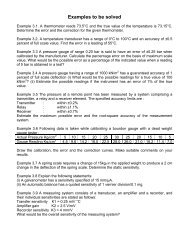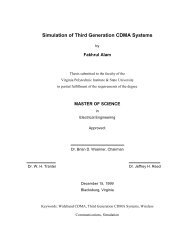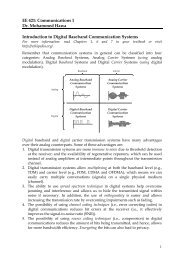Measurement Lab. Resistance Temperature Detector (RTD) - FET
Measurement Lab. Resistance Temperature Detector (RTD) - FET
Measurement Lab. Resistance Temperature Detector (RTD) - FET
Create successful ePaper yourself
Turn your PDF publications into a flip-book with our unique Google optimized e-Paper software.
Many wire insulating materials become brittle at subzero temperatures and therefore should notbe used for cryogenic work. So state the intended temperature range right up front and let theapplications engineer assist you, especially since it may affect the materials chosen for internalconstruction of the probe.AccuracyYou are probably wondering why accuracy was not the first topic covered, because <strong>RTD</strong>'s aregenerally known for their high degree of accuracy and it is typically one of the firstspecifications laid out. Well, the subject is not quite that simple, and it requires a bit ofdiscussion. First, we must establish the difference between accuracy, precision, and repeatability.In the case of temperature, accuracy is commonly defined as how closely the sensor indicates thetrue temperature being measured, or in a more practical sense, how closely the resistance of the<strong>RTD</strong> matches the tabulated or calculated resistance of that type <strong>RTD</strong> at that given temperature.Precision, on the other hand, is not concerned with how well the <strong>RTD</strong>'s resistance matches theresistance from a look-up table, but rather with how well it matches the resistance of other <strong>RTD</strong>'ssubjected to that temperature. Precision generally refers to a group of sensors, and if the grouphas good precision at several temperatures, we can also say that they are well matched. This isimportant when interchangeability is a concern, as well as in the measurement of temperaturegradients. Repeatability can best be described as the sensor's ability to reproduce its previousreadings at a given temperature.Our final two parameters are application dependent and vary from the specification of a bareresistance element to a large industrial assembly with thermowells, connection heads, andpossibly field -mounted transmitters. We will discuss only the most basic areas: physicaldimensions and size restrictions, and material compatibility.Material CompatibilityMost people specifying <strong>RTD</strong> probes have to pay attention only to the chemical compatibility thatwill prevent corrosion. This is generally straightforward and guidelines can be taken from othermaterials used in the system in which the <strong>RTD</strong> will be installed. If the piping system isconstructed of 316 S.S., then the probe probably should be also. But always check a corrosionguide for corrosion rates and material recommendations if you have the slightest doubt.For applications involving thermowells, the thermowell will carry the burden of corrosionprotection. However, be sure to protect the connecting wires and any terminals or plugs frompossible corrosion caused by splash or corrosives in the atmosphere.Applications of <strong>Resistance</strong> <strong>Temperature</strong> <strong>Detector</strong>s• Air conditioning and refrigeration servicing• Food Processing• Stoves and grills• Textile production• Plastics processing• Petrochemical processing• Micro electronics• Air, gas and liquid temperature measurement• Exhaust gas temperature measurement
















